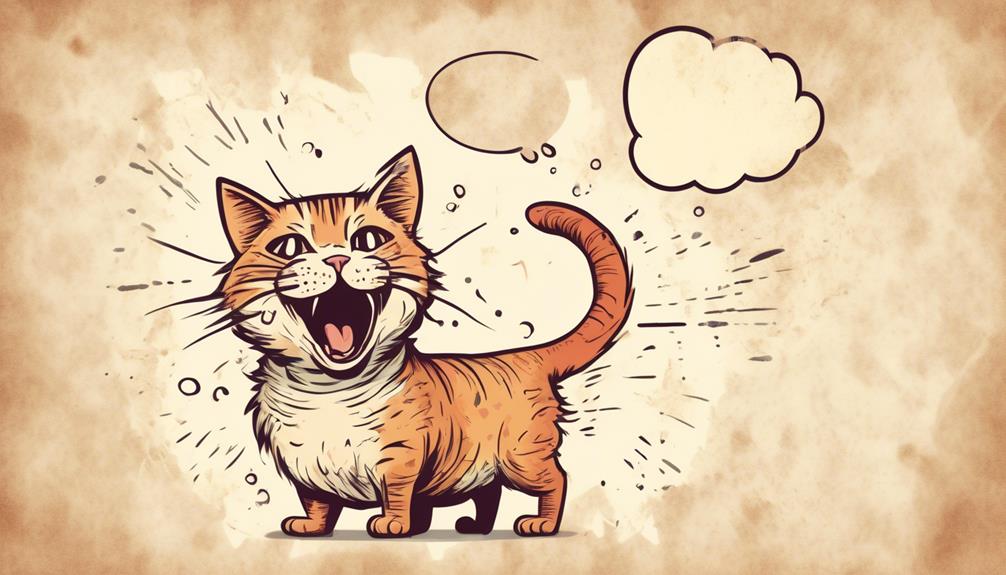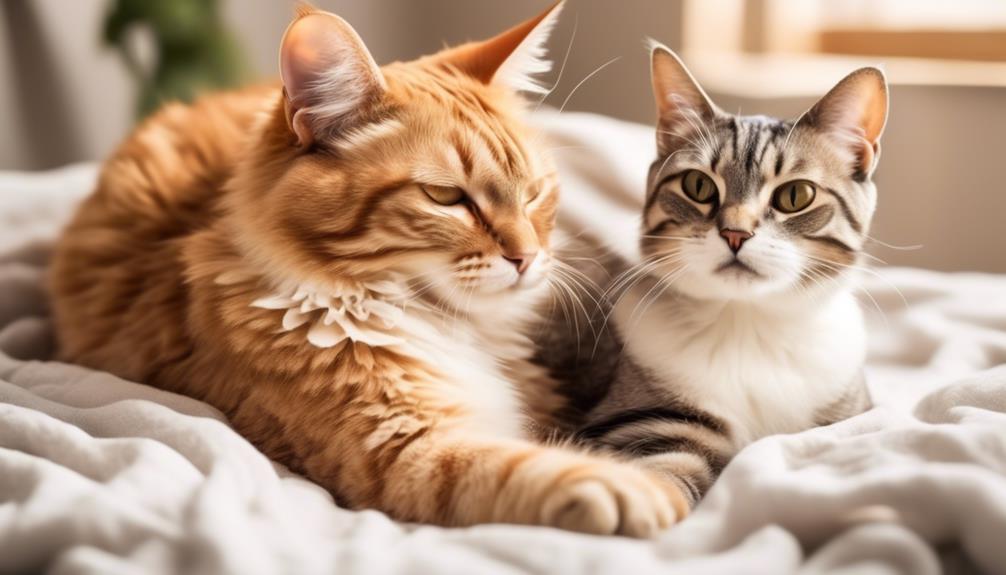14 Key Indicators of Your Cat's Health Behavior
Your cat's behavior is like a window into its well-being, offering you subtle clues about its health. Paying attention to the 14 key indicators of your cat's behavior can provide valuable insights into its overall health and happiness.
From eating patterns to social interaction, each aspect of your cat's behavior can reveal important information about its physical and emotional state. Understanding these indicators can help you detect potential health issues early and ensure your feline companion receives the care it needs to thrive.
Eating Patterns
Observing your cat's eating patterns can provide valuable insight into their overall health and well-being. Weight management is an essential aspect of your cat's health, and monitoring their food intake is crucial.
Cats, like humans, can struggle with weight issues, and their eating patterns can be indicative of whether they're maintaining a healthy weight. If your cat suddenly starts eating significantly more or less than usual, it could signal an underlying health issue that needs attention.
Keeping an eye on their food preferences is also important. Just like humans, cats have their own preferences when it comes to food. If your cat suddenly loses interest in their favorite food, it could be a sign of dental problems, digestive issues, or even stress. On the other hand, an increase in food preferences may lead to overeating, which can contribute to weight gain.
When it comes to weight management, paying attention to your cat's eating patterns and food preferences is crucial. If you notice any significant changes in their eating habits or preferences, it's important to consult with a veterinarian to rule out any potential health concerns. By being proactive and observant, you can help your cat maintain a healthy weight and overall well-being.
Sleeping Habits
Monitoring your cat's eating patterns has provided valuable insight into their overall health; now, let's examine their sleeping habits to further understand their well-being.
When it comes to your cat's sleeping habits, paying attention to their bedtime routines and sleep environment can offer important clues about their health.
- Bedtime Routines
- Consistency: Cats are creatures of habit, so paying attention to their bedtime routines can reveal a lot about their overall well-being. If your cat suddenly changes their bedtime habits, such as staying awake all night or sleeping more than usual, it could be a sign of an underlying health issue.
- Activity Levels: Observing your cat's activity levels before bedtime can also provide insights into their health. If your usually active cat becomes lethargic before bedtime, it might be worth investigating further.
- Sleep Environment
- Comfort: Cats are known for their love of comfortable and cozy spots. Ensuring that your cat's sleep environment is comfortable and free of disturbances can contribute to their overall well-being.
- Temperature: Cats are sensitive to temperature, so ensuring that their sleep environment is neither too hot nor too cold is essential for their quality of sleep.
Grooming Behavior
Cats' grooming behavior is an essential aspect of their daily routine and reflects their overall health and well-being. Regular grooming helps your cat to maintain a healthy coat and skin. It also provides an opportunity for you to observe any changes in their fur, skin, or overall health. One key indicator to watch for is fur matting. If you notice tangled or matted fur, it could be a sign that your cat isn't grooming themselves adequately, which may indicate an underlying health issue such as obesity, arthritis, dental problems, or skin conditions. In some cases, older cats may struggle to groom themselves effectively due to arthritis or other age-related issues, so regular brushing and grooming assistance may be necessary to prevent fur matting.
Another important aspect of grooming behavior is hairball prevention. Cats groom themselves by licking their fur, and this can lead to the ingestion of loose hairs. While it's normal for cats to have hair in their stomach, excessive hair ingestion can lead to hairballs, which can cause digestive issues. To help prevent hairballs, regular brushing to remove loose fur, providing a high-fiber diet, and offering specific hairball prevention treats can all be beneficial. Additionally, ensuring that your cat stays hydrated can help pass any ingested hair through their system more easily.
Monitoring your cat's grooming behavior and taking proactive steps to prevent fur matting and hairballs can contribute to their overall health and well-being.
Litter Box Usage
If you've noticed any changes in your cat's litter box usage, it can be an important indicator of their overall health and well-being. Monitoring your cat's litter box habits can provide valuable insights into their health status. Here are a few key indicators to consider:
- Litter Box Cleanliness
- Pay attention to how often you need to clean the litter box. A sudden increase in the frequency of litter box cleaning may indicate that your cat is using the litter box more frequently, which could be a sign of an underlying health issue. On the other hand, if you notice that your cat is avoiding the litter box or showing reluctance to enter it, it could be a sign of discomfort or an aversion to the litter box itself. Keeping the litter box clean and odor-free is essential to encourage regular use.
- Elimination Frequency
- Keep an eye on your cat's elimination frequency. Changes in the frequency of urination or defecation could signal potential health problems. If your cat is using the litter box more frequently than usual, it might indicate a urinary tract issue. Conversely, if your cat is visiting the litter box less often, it could be a sign of constipation or other gastrointestinal issues. It's important to note any significant deviations from your cat's regular elimination patterns and consult a veterinarian if you have concerns.
Vocalization Changes

Noticing changes in your cat's vocalization patterns can offer valuable insights into their overall well-being and health status. Cats are known for their wide range of vocalizations, from meows and purrs to hisses and yowls. Any significant deviation from your cat's usual vocal behavior could be a potential indicator of an underlying issue. One key aspect to consider is stress indicators. Cats may vocalize more or less than usual when they're stressed. Increased vocalization can be a sign of distress, while decreased vocalization may indicate that your cat is feeling unwell or anxious. It's important to pay attention to these changes and observe your cat's body language and other behaviors to better understand their communication cues.
If your cat is suddenly meowing excessively or crying out in pain, it could be a signal that something is wrong. On the other hand, if your typically chatty cat becomes unusually quiet, it might be a sign that they're feeling unwell. Monitoring these vocalization changes can help you identify potential health issues early on and seek appropriate veterinary care.
In addition to stress and health-related vocal changes, it's essential to consider your cat's communication cues. Cats may use different vocalizations to express their needs, desires, or discomfort. By paying attention to these cues, you can better understand your cat's emotions and address any potential health concerns promptly. Keep in mind that every cat is unique, so being attuned to their individual vocalization patterns is crucial for maintaining their overall well-being.
Physical Activity
Paying attention to your cat's physical activity levels can provide further insight into their overall well-being and health status, complementing the information gained from vocalization changes. Monitoring your cat's playtime routines and exercise needs is crucial in ensuring they maintain a healthy level of physical activity. Engaging your cat in regular play sessions not only helps them stay physically fit but also provides mental stimulation, contributing to their overall well-being.
When considering your cat's physical activity, it's essential to evaluate their indoor versus outdoor activity levels. Indoor cats may have different exercise needs compared to those allowed outdoor access. Providing indoor cats with interactive toys, climbing structures, and engaging in regular play can help meet their exercise requirements. On the other hand, outdoor cats may have more opportunities for natural physical activity, but it's still important to monitor their overall levels of movement and play.
Furthermore, maintaining an optimal weight is crucial for your cat's overall health. Regular physical activity plays a significant role in weight management. By promoting exercise through play and interactive activities, you can help prevent obesity and related health issues in your cat. Monitoring your cat's physical activity levels and addressing any concerns can contribute to their long-term health and well-being.
Social Interaction

Ensuring your cat has ample opportunities for social interaction with both humans and other animals is essential for their mental and emotional well-being. Playful engagement is a vital aspect of your cat's social interaction.
Cats are naturally playful creatures, and interactive playtime with their human companions or other animals can greatly enrich their lives. Engaging in activities such as feather wand play, laser pointer games, or interactive toys can help strengthen the bond between you and your cat while providing them with mental stimulation and physical exercise.
Feline communication is another crucial element of social interaction for cats. Cats have their unique ways of communicating, and understanding their body language and vocalizations is key to fostering a strong social connection. Pay attention to your cat's tail position, ear movements, and vocal cues to gauge their mood and needs. Responding appropriately to their communication signals can help them feel understood and valued, strengthening the bond between you and your feline companion.
Additionally, providing opportunities for your cat to interact with other animals, such as other cats or cat-friendly dogs, can contribute to their social well-being. Supervised introductions and positive interactions with other pets can help prevent loneliness and boredom, promoting a happier and more socially fulfilled cat. Remember, each cat has its unique social preferences, so observe and respect your cat's comfort level and boundaries when facilitating social interactions with other animals.
Behavioral Changes
You may observe your cat exhibiting changes in behavior, which could indicate underlying health issues or environmental stressors. Being attuned to these shifts is crucial for maintaining your cat's well-being.
Some key behavioral changes to be mindful of include:
- Stress Indicators and Mood Swings
Keep an eye out for signs of stress, such as excessive grooming, hiding, or changes in appetite. Cats can also experience mood swings when under duress, so sudden shifts in behavior should be noted and monitored closely.
- Aggression and Anxiety
Unexplained aggression or heightened anxiety in your cat could be a red flag for underlying health issues or environmental stressors. Aggressive behavior or excessive fearfulness may indicate that your cat is feeling unwell or unsafe in its environment.
These behavioral changes could be indicative of an array of health concerns, including but not limited to pain, illness, or psychological distress. Monitoring your cat's behavior and promptly addressing any concerning changes with a veterinarian is crucial for early intervention and treatment.
Frequently Asked Questions
How Can I Tell if My Cat Is Experiencing Stress or Anxiety?
You can tell if your cat is experiencing stress or anxiety by recognizing behavioral changes. Common stress indicators include excessive grooming, hiding, or aggression. Try anxiety management techniques like creating a calm environment and providing interactive toys.
Are There Any Warning Signs of Potential Health Issues That I Should Be on the Lookout for in My Cat's Behavior?
You should be on the lookout for signs of illness and behavioral changes in your cat. These could indicate stress symptoms or anxiety. It's important to address these issues to provide relief for your cat.
What Can I Do to Help My Cat Maintain a Healthy Weight and Exercise Regularly?
To help your cat maintain a healthy weight and exercise regularly, you can provide a balanced diet, engage in interactive play sessions, and create an enriching environment. Regular vet check-ups and monitoring food portions can also be beneficial.
How Often Should I Take My Cat to the Vet for Check-Ups, and What Should I Expect During These Visits?
You should take your cat to the vet for check-ups at least once a year. During these visits, you can expect vaccination schedules, preventive care, as well as discussions about grooming habits and dental care.
Is There a Way to Monitor My Cat's Overall Mental and Emotional Well-Being?
You can monitor your cat's mental and emotional well-being by understanding feline communication. Look for signs of contentment like relaxed body posture and purring, and signs of distress like hiding or aggressive behavior.
Conclusion
Overall, paying attention to these 14 key indicators of your cat's health behavior can give you valuable insight into your furry friend's well-being. By observing their eating patterns, sleeping habits, grooming behavior, and litter box usage, you can ensure that your cat is happy and healthy.
Additionally, monitoring any vocalization changes, physical activity levels, and social interaction can provide further clues about your cat's overall health. These behaviors can indicate if your cat is experiencing any discomfort or if there are any underlying medical issues.
It's important to note that any behavioral changes should not be ignored. If you notice any concerning changes in your cat's behavior, it's always best to consult with a veterinarian. They can provide professional guidance and help determine if there are any underlying health issues that need to be addressed.
Remember, your cat's health and well-being are a top priority. By keeping a close eye on their behavior and seeking veterinary assistance when needed, you can ensure that your feline companion remains happy and healthy for years to come.
